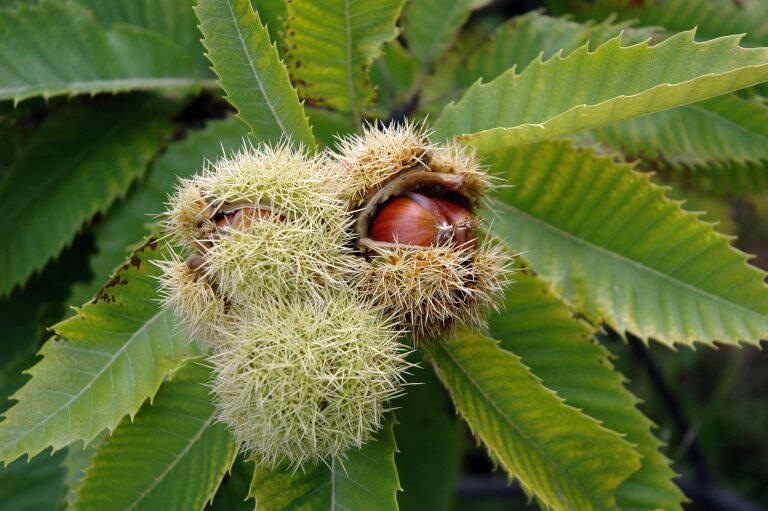Starchy, sweet, rich in flavor, chestnuts are popular edible nuts of the northern hemisphere origin. The nuts are native to the mountainous forests of China, Japan, Europe, and North America.
The fruit is quite larger compared to other tree nuts such as cashews and macadamias. Each nut features a smooth, glossy, dark-brown outer shell, 1-1.5 inches in diameter and weighing 8-12 grams depending upon the species. Inside, its sweet and starchy kernel features outer brown but inner creamy white flesh.
Before chestnuts can be cooked to make delicious dishes, the shell has to be removed. After washing and drying them, slice each side of the shell and microwave on high for about 2 minutes. After letting them cool a little, the shell can easily be removed.
Nutritional facts
Chestnuts, unlike other nuts and seeds, are relatively low in calories and fats and are an excellent source of dietary fiber. A high fiber diet helps lower blood cholesterol levels by limiting excess cholesterol absorption in the intestines.
Chestnuts stand out from other edible nuts for their distinctive nutrition profile. They are exceptionally rich in vitamin C. Being a strong antioxidant, it offers protection from harmful free radicals.

Chestnuts are rich in folates akin to green leafy vegetables, which is quite a rare but unique feature for nuts and seeds. Folic acid is essential for the formation of red blood cells, and DNA synthesis.
Like true nuts, they too are a rich source of monounsaturated fatty acids. Studies suggest that monounsaturated fats (MUFs) in the diet help lower total as well as LDL (bad cholesterol) and increase HDL (good cholesterol) levels within the blood.
The nuts are also an excellent source of minerals such as iron, calcium, magnesium, manganese, phosphorus, and zinc, besides providing a very good amount of potassium.
They are also rich in many important B-complex groups of vitamins. Just 100 g of nuts provide 11% of niacin, 29% of pyridoxine (vitamin B-6), 100% of thiamin, and 12% of riboflavin.
Chestnuts, just like hazelnuts and almonds, are gluten-free food items.
Chinese chestnuts (C. mollissima) are a good source of vitamin A.
Use in traditional Chinese medicine
According to traditional Chinese medicine (TCM), chestnuts are regarded as “fruit for the kidney and patients with renal diseases.” It is a warming food that nourishes the qi of the gastrointestinal system, spleen, and kidneys. Kidney nourishment is especially important for those who have a sore lumbar spine, frequent urination at night, or loose teeth.
Chestnuts are also used in TCM to improve circulation and are eaten daily by the elderly in China to prevent and treat high blood pressure, heart disease, hardening of the arteries, and osteoporosis. Additionally, the chestnut is high in carbohydrates. Its energy warming quality is good for suppressing and combating colds. It is also used as a tonic food during autumn and winter.

Fried chestnuts with sugar
This Chinese recipe involves frying chestnuts in a cauldron of sand drizzled with sugar syrup. The purpose of the sand is to heat them evenly and also to retain their inherent sweetness.
When they are finished cooking, chew them slowly. If you eat too many at once, you can harm your spleen and stomach. They might not taste sweet at first, but the sweetness will eventually come out.
This unique sweet flavor is known as the “flavor of happiness.” Other recipes using chestnuts include pork shoulder soup and fried chicken with chestnuts.
Eating chestnuts raw can be just as beneficial to one’s health as eating them cooked. According to TCM, eating them raw can cure lower back and leg problems caused by weak kidneys. Every morning and evening, the patient should slowly chew a few until they become a white pulp, and then slowly swallow. Eaten with pig kidney porridge, over time, can also help a patient’s physical condition.
About 5 to 10 chestnuts a day is considered enough. Since a child’s digestive system is less developed, children should eat fewer chestnuts.
Follow us on Twitter, Facebook, or Pinterest








